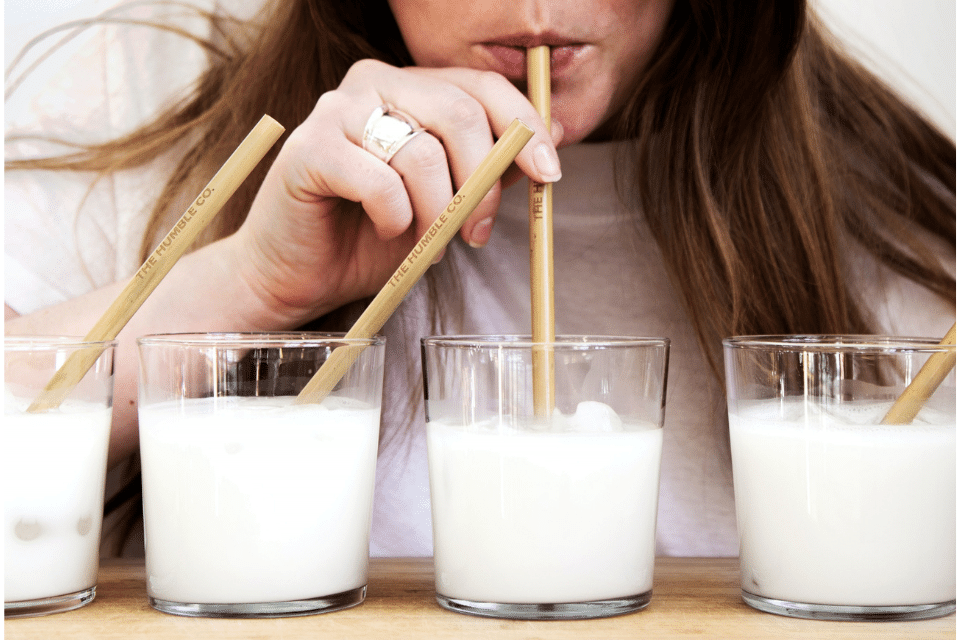Are you experiencing digestive issues and not sure what the cause is? Many people automatically eliminate dairy and gluten from their diet, often unnecessarily. If you have been diagnosed with IBS, then may I suggest a more gentle approach: lactose-free!
First, let’s backtrack and talk about what dairy is exactly. Dairy products like milk, cheese, yogurt, and ice cream come from the milk of mammals. In the United States, we typically consume dairy products from cows, goats, or sheep but you can also find dairy products from camels or buffalo! Dairy products contain a milk sugar called lactose, which is typically the cause of so many people’s digestive distress. Lactose requires the enzyme lactase to digest it. When you are missing this enzyme, lactose is malabsorbed in the gut, pulls water into small intestines, and passes undigested into the colon where it is fermented. This then creates gas, bloating, abdominal pain, and diarrhea. Unfortunately, it’s estimated that about 65% of the world’s population is missing this enzyme and diagnosed as lactose intolerant.
What about dairy-free options, are they low FODMAP?
Dairy-free products are typically made from nuts, seeds, grains, or beans. All dairy-free products are lactose-free, meaning they do not contain any lactose. However, this doesn’t mean that they’re low FODMAP. For example, let’s look at soy. Soy milk is a great dairy-free alternative, but its FODMAP content depends on whether it’s made from a soybean or soy protein. Most products in the U.S. are made from soybeans, which means that this isn’t a great option during the elimination phase. Other products like almond milk or coconut yogurt are considered low FODMAP. You can read more about high and low FODMAP food lists here or refer to the Monash app.
Dairy and IBS
So, how are people with lactose intolerance supposed to enjoy dairy products? There are quite a few options out there. Let’s dive in!
If you’ve been diagnosed with IBS, then you’ve likely heard of the low FODMAP diet. A common misconception is that the low FODMAP diet is a dairy-free diet. It’s actually a low-lactose diet. The “D” in FODMAP even stands for disaccharide, AKA lactose. This means that products high in lactose are removed during the elimination phase and then tested during the reintroduction phase. Many of my patients are ecstatic when they find this out because it means that cheese can still be a part of their diet (and who doesn’t love cheese?). Let’s look at the different types of dairy products, their lactose content, and where they fall in the Low FODMAP diet.
- Cheese: Most cheeses are low in lactose, making them low FODMAP friendly. A good rule of thumb is to stick to small portions (about one ounce) of hard or aged cheeses. Monash University has tested many different cheeses and found the following to be low lactose (i.e. it contains one gram of lactose or less per serving): Gruyere, Manchego, Monterey Jack, cheddar, Swiss, Brie, feta, mozzarella, small amounts of ricotta and goat. Love cottage cheese or cream cheese? They both have low FODMAP serving sizes (about two tablespoons) or you can search out a lactose-free version. Green Valley Creamery makes both of these options.
- Milk: A glass of cow’s milk (8oz) contains about 12g of lactose, making this a high FODMAP food. There are lactose-free cow’s milk varieties out there, where the lactase enzyme is added to the milk. The addition of the enzyme breaks down the lactose, making it a lactose-free food. You can find it from brands like Lactaid or FairLife. Non-dairy milks that are low FODMAP include almond, macadamia, rice, and quinoa. As previously mentioned, soy milk varies based on soybean or soy protein. Other non-dairy milks, like coconut, hemp, and oat are portion-size-dependent.
- Yogurt: This is a tricky one because it depends on the style and portion size. Regular yogurt has a small low FODMAP serving size as does Greek yogurt. There are lactose-free varieties out there that have the lactase enzyme added. Green Valley Creamery and Fage make great lactose-free cow’s milk yogurts. The only non-dairy option that has been tested is coconut. You’re likely ok with almond or cashew-based yogurts as their milks have been tested but start with a small serving to see how your body reacts.
- Ice cream: This is another high FODMAP food. Luckily, there are brands like Beckon that have the lactase enzyme added to their products. Non-dairy options have not been tested by Monash, but are typically ok depending on what product is used (soy, coconut, almond) and any other added ingredients.
If you go through the phases of the low FODMAP diet and find out that you are lactose intolerant, you still have options. Part of this depends on how sensitive to lactose you are along with your preferences. You can look for lactose-free products that have the lactase enzyme already added, or you can talk with your healthcare provider about taking a lactase enzyme. They may recommend a specific dose and tailor it to your tolerance level.
References
Lactose intolerance: MedlinePlus Genetics. (2020, August 18). Retrieved May 05, 2021, https://medlineplus.gov/genetics/condition/lactose-intolerance/#frequency


